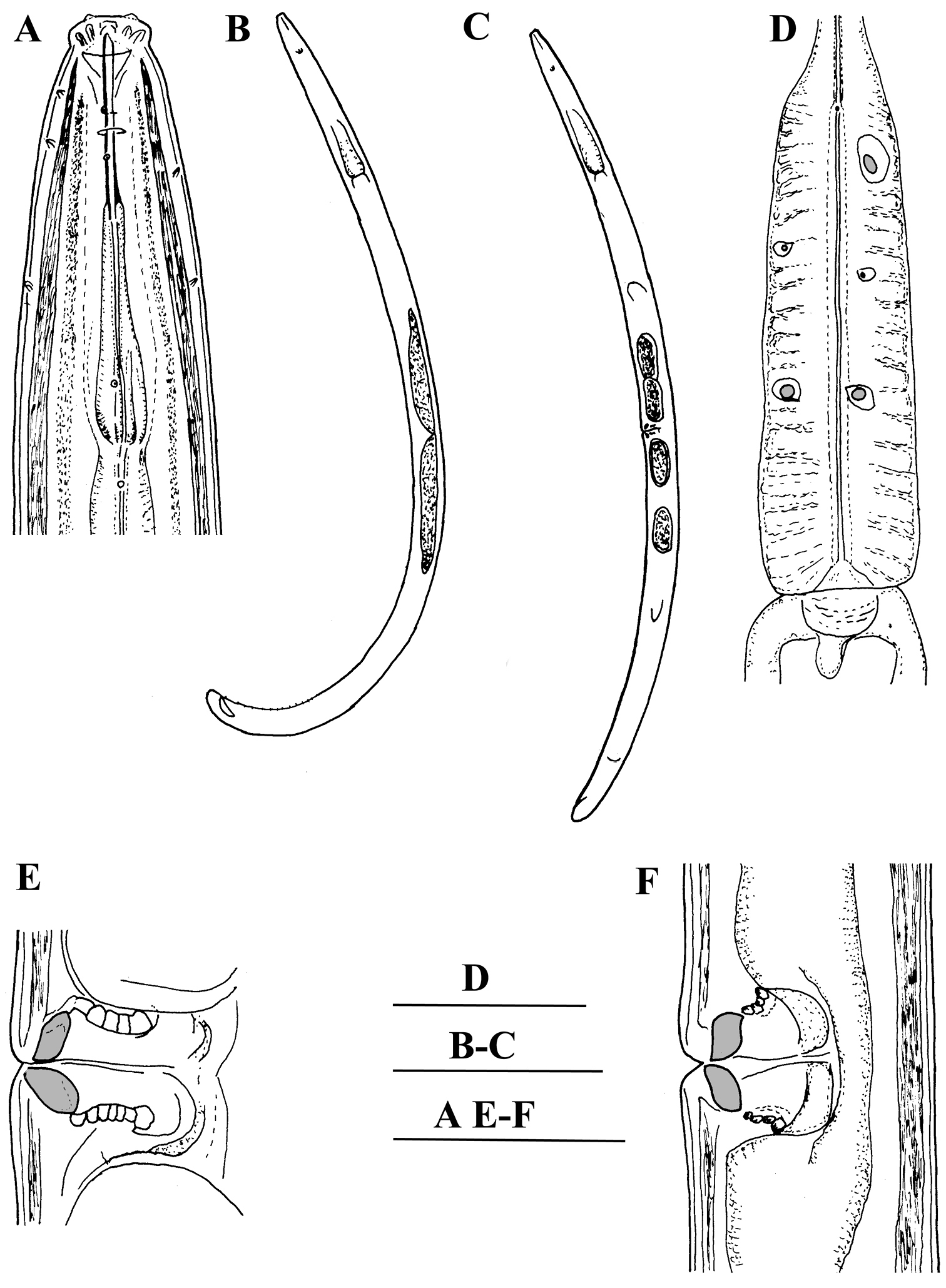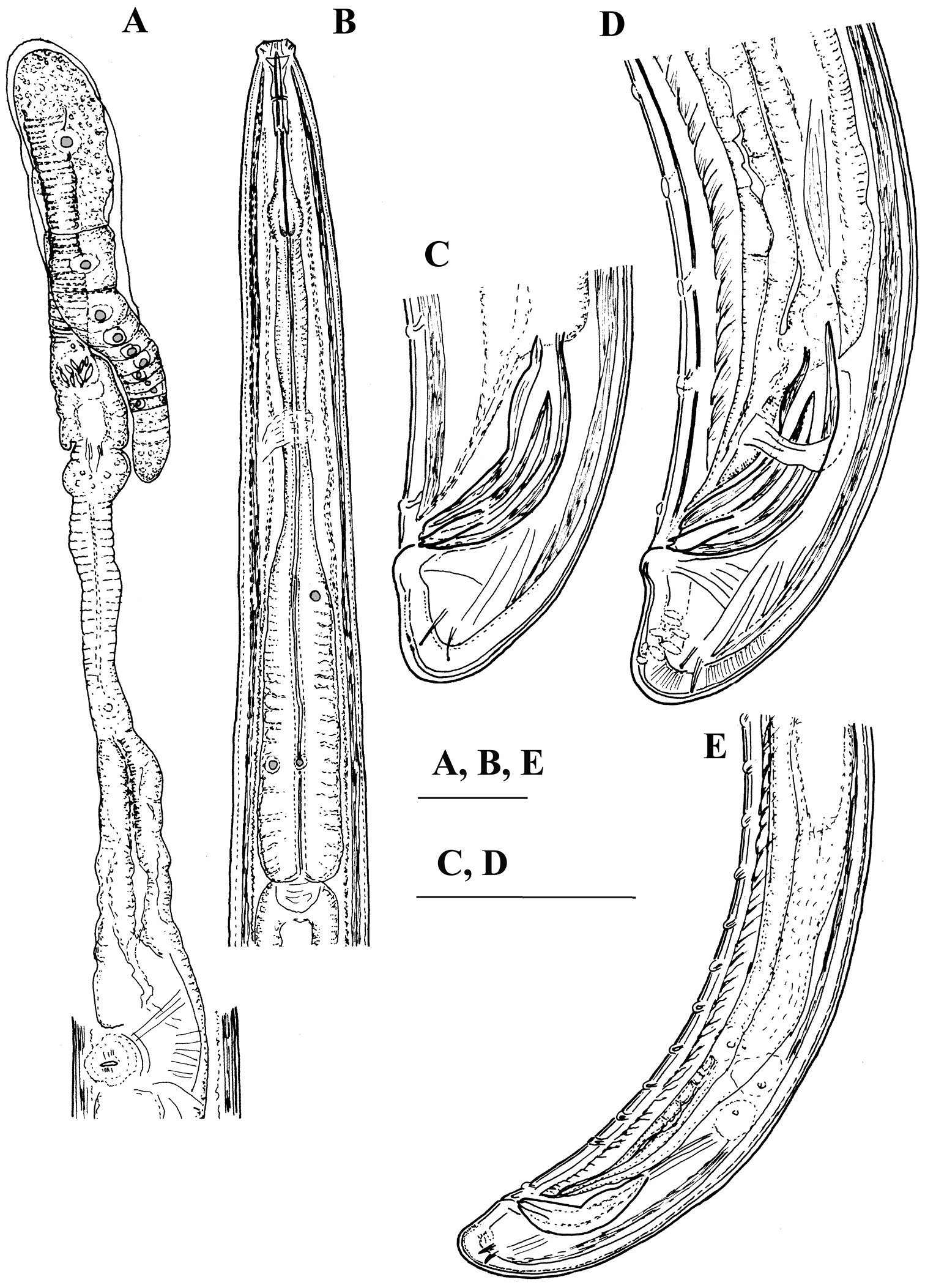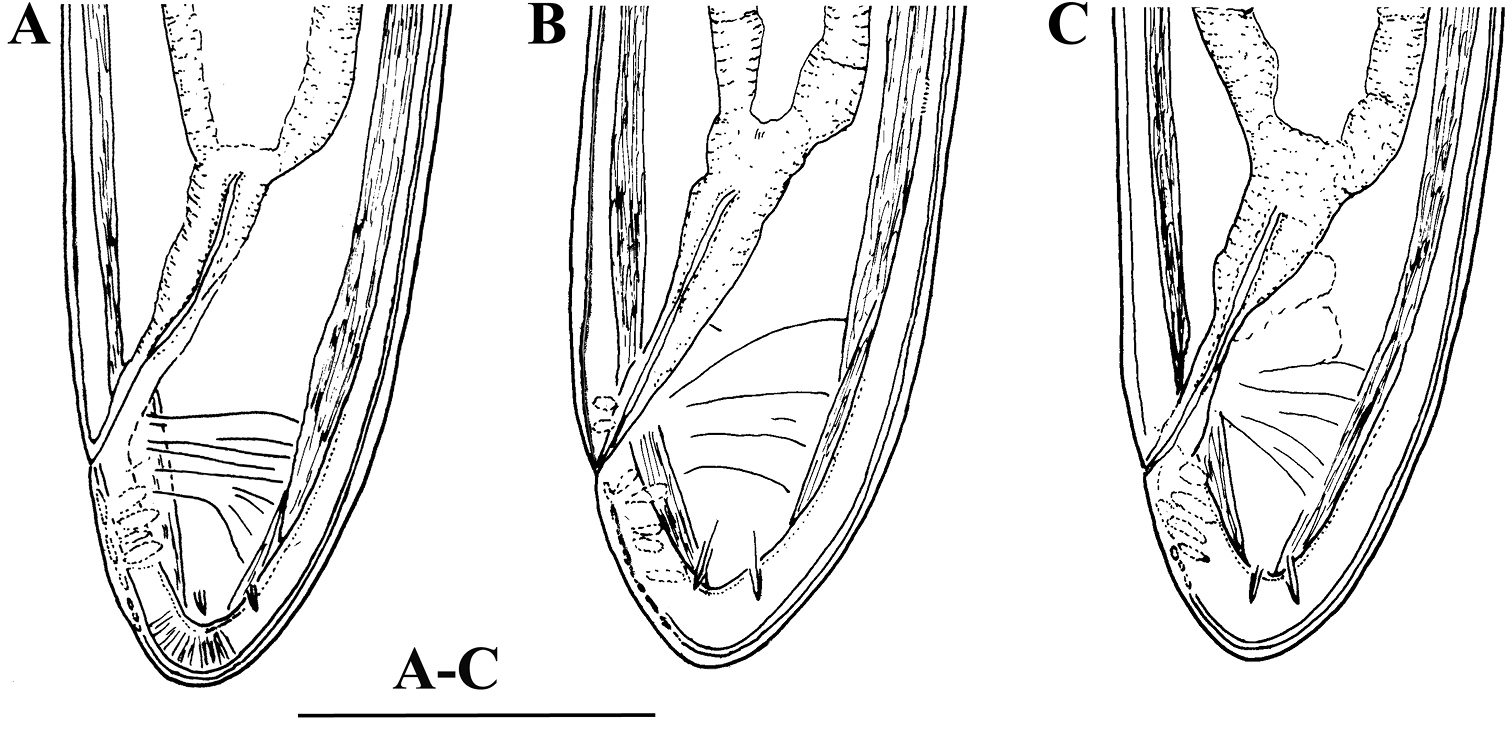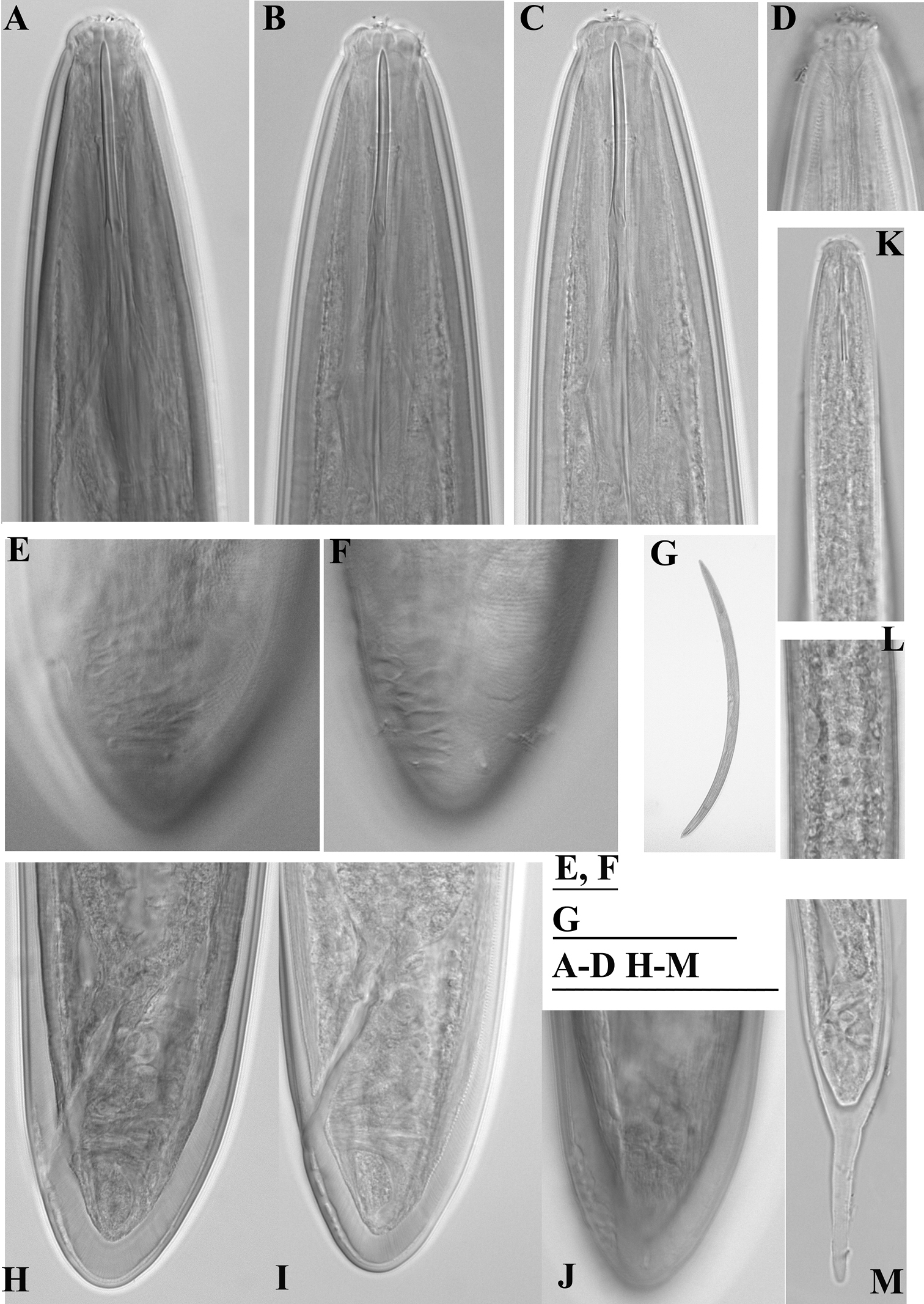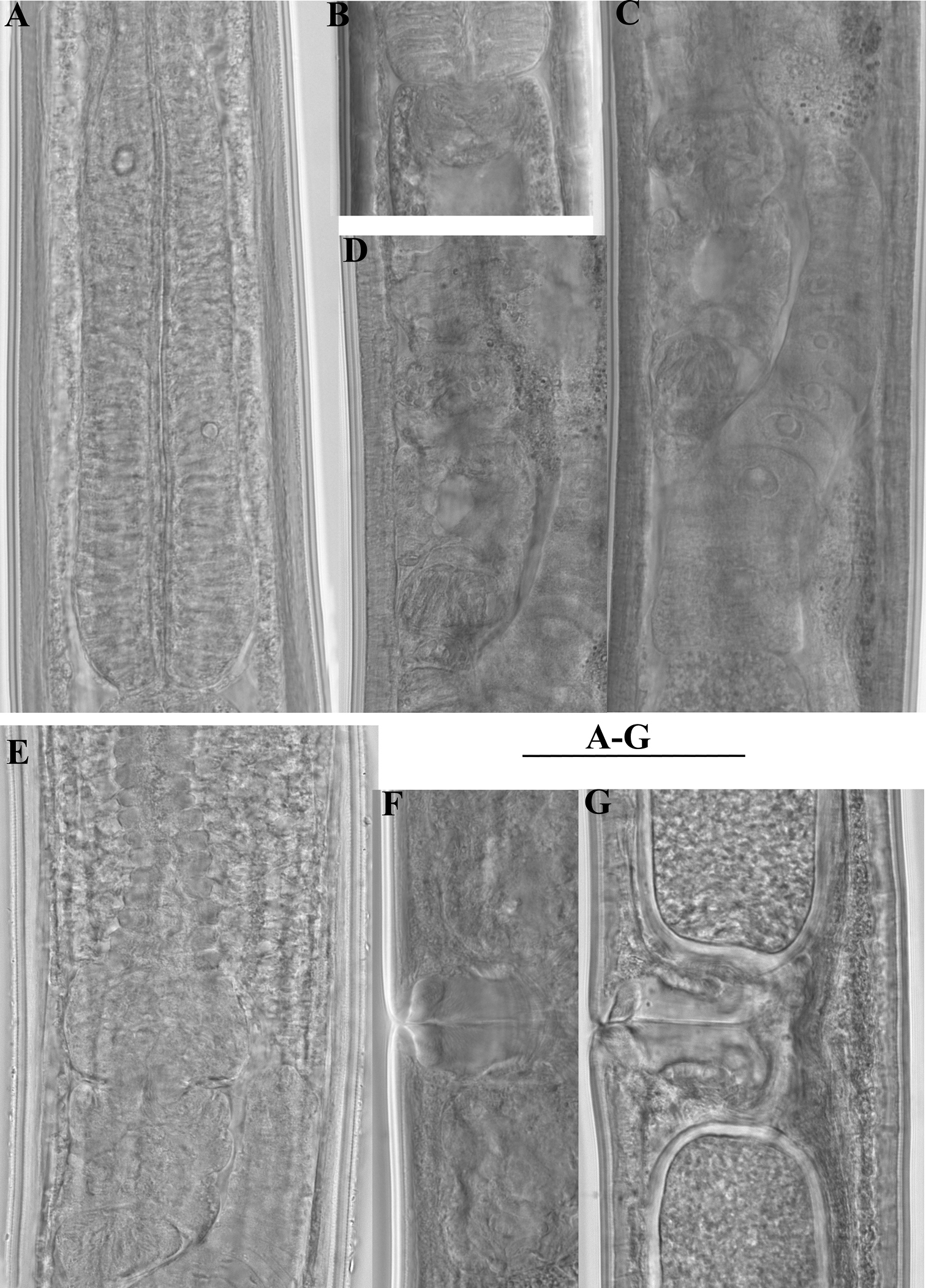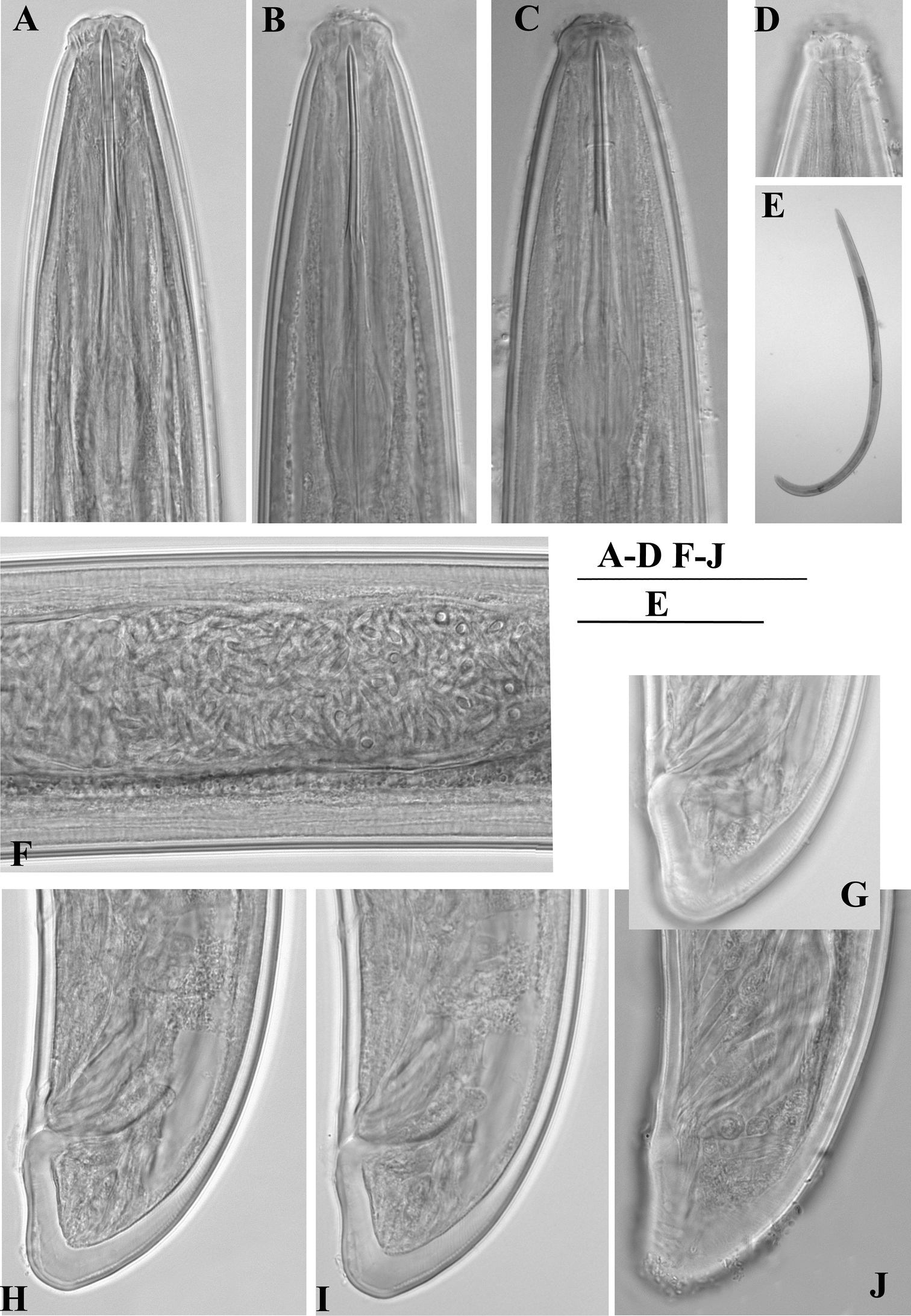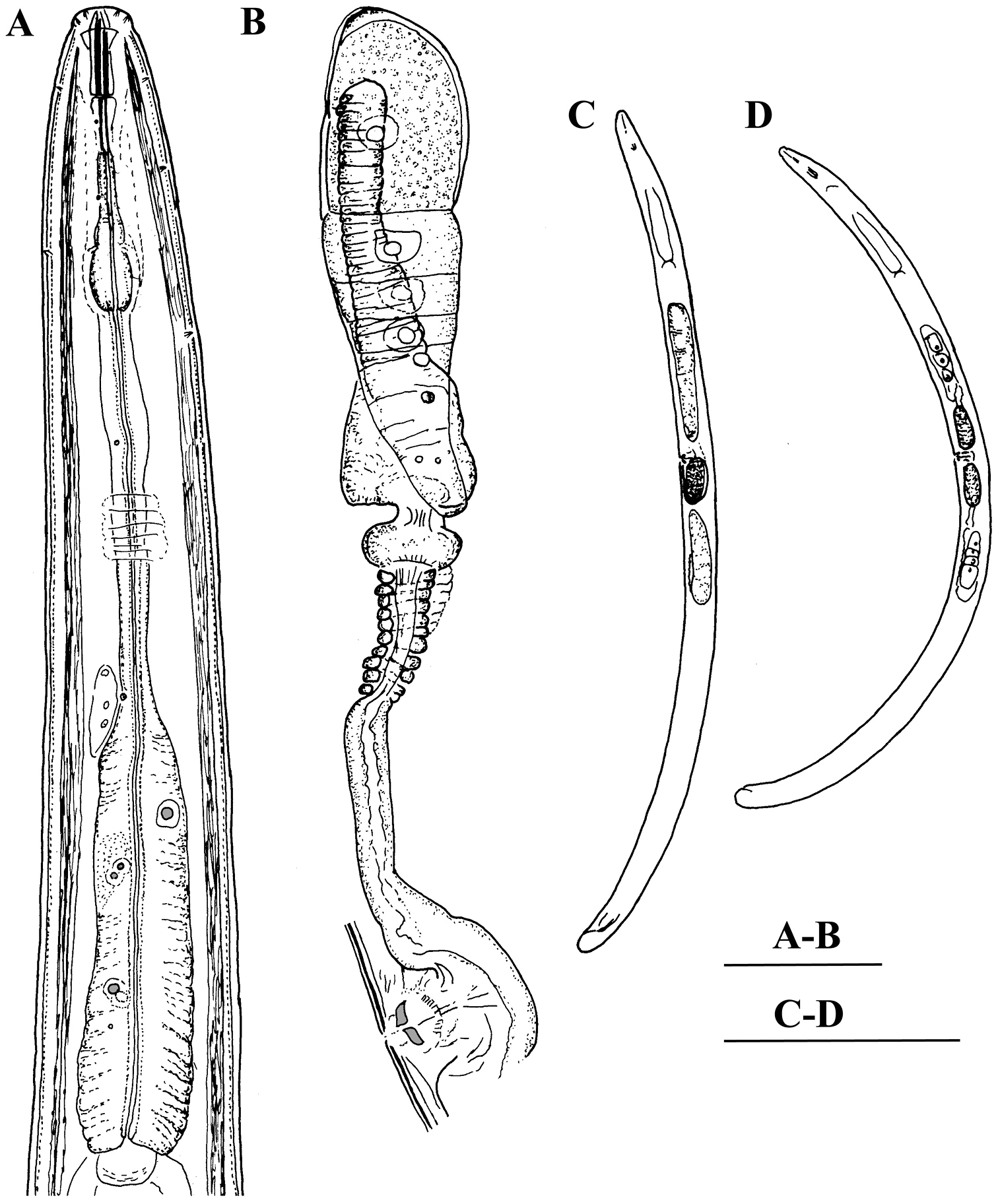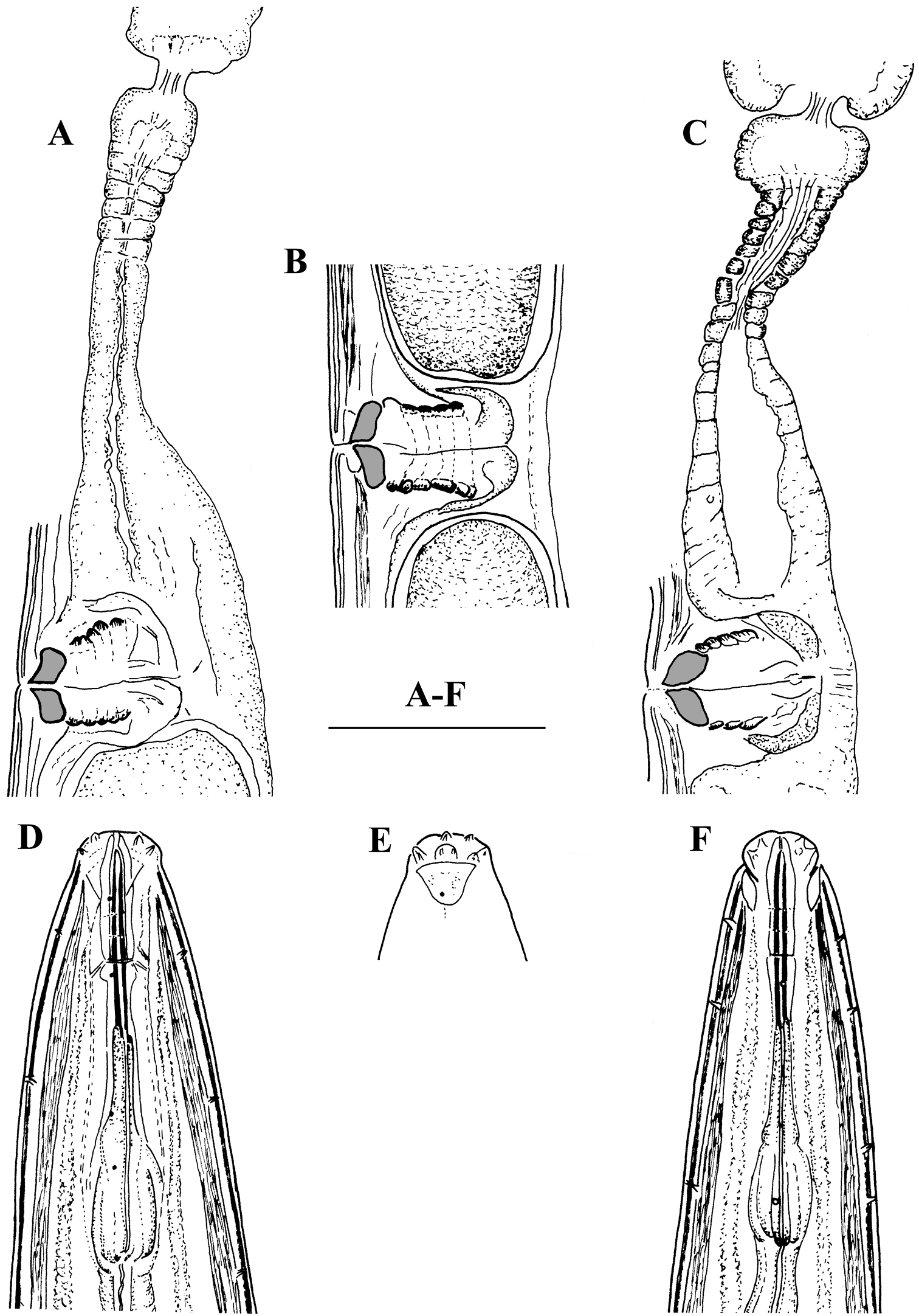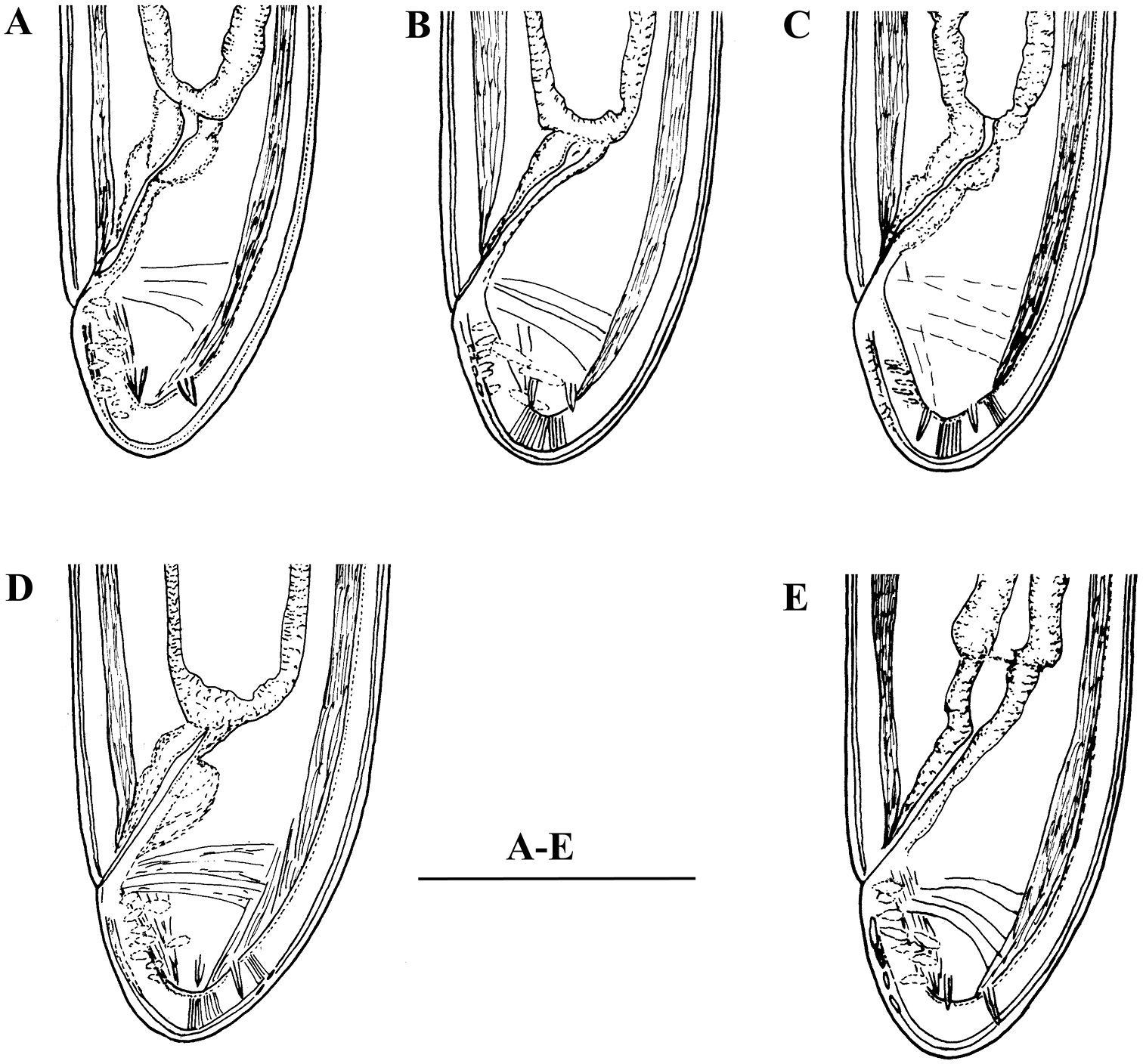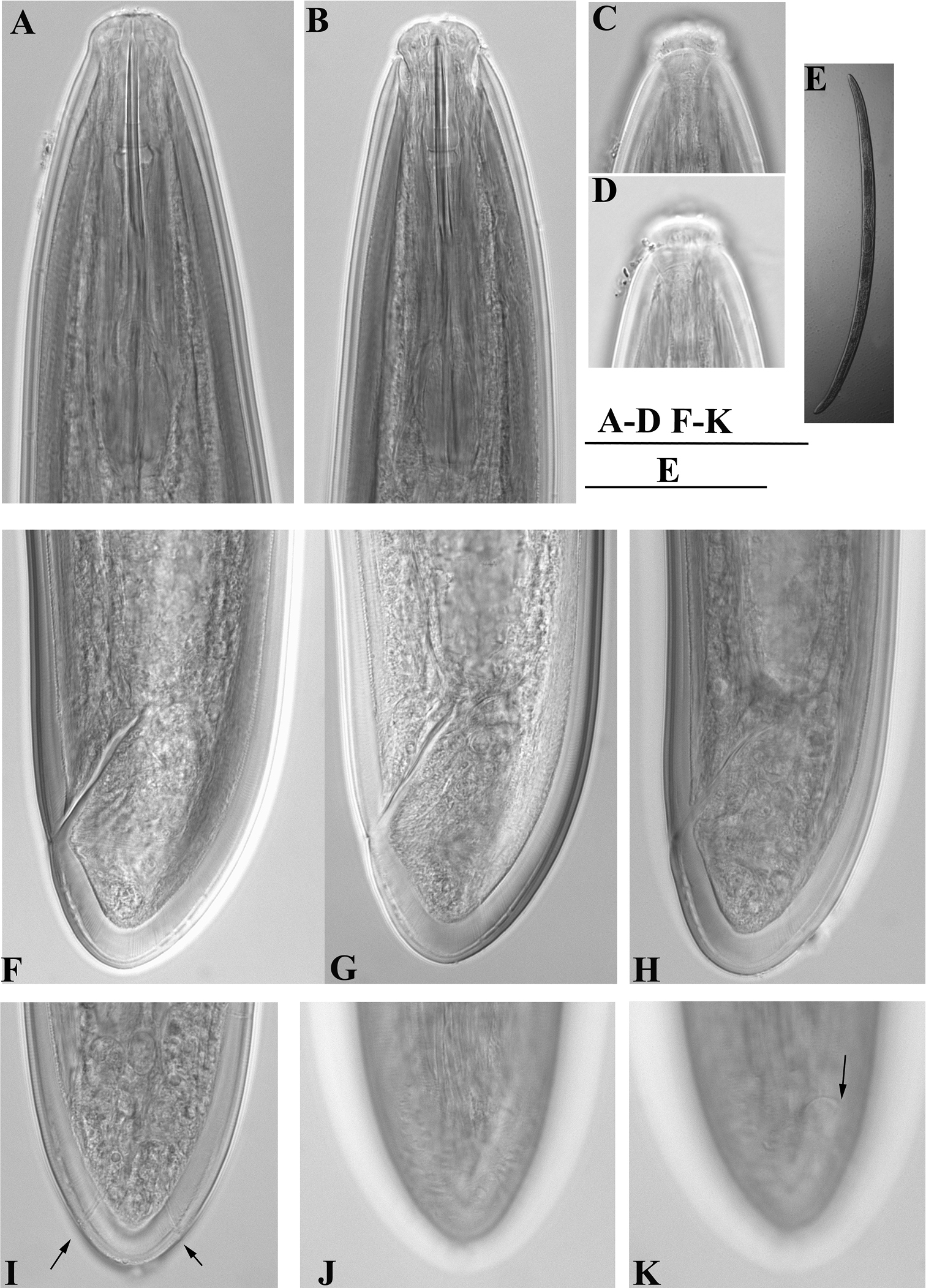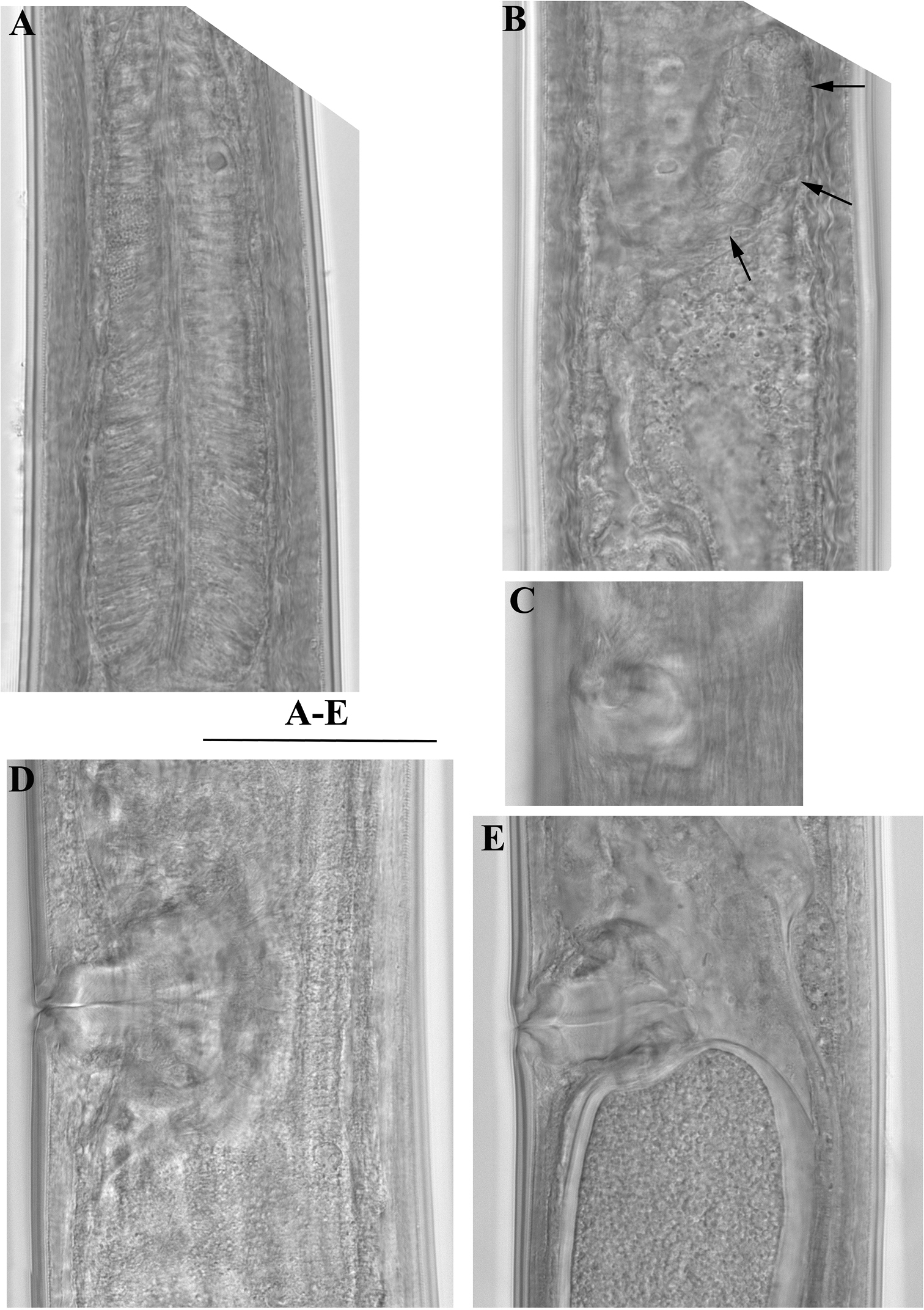






(C) 2012 Milka Elshishka. This is an open access article distributed under the terms of the Creative Commons Attribution License 3.0 (CC-BY), which permits unrestricted use, distribution, and reproduction in any medium, provided the original author and source are credited.
For reference, use of the paginated PDF or printed version of this article is recommended.
Two nematode species of the genus Enchodelus Thorne, 1939, one new and one known from Arctic polar deserts were studied. Enchodelus makarovae sp. n. is an amphimictic species, characterised by females with body length of 1.57–2.00 mm, lip region 15–17.5 µm wide, amphid duplex, odontostyle 38–43 µm long or 2.3–2.8 times lip region diam. Odontophore with flanges, 1.2–1.4 times as long as odontostyle; pharynx length 320–377 µm, pharyngeal expansion 113–130 µm long or 32–37% of total pharynx length; female genital system amphidelphic, uterus tripartite, pars refringens vaginae with two trapezoid sclerotisations, vulva a transverse slit (V=45–51%); tail bluntly conoid (25–35 µm, c=45.8–70.3, c’=0.6–0.9 in females, and 29–33 µm, c=46.4–58.9, c’=0.7–0.8 in males). Males with 65–74 µm long spicules and 10–12 spaced ventromedian supplements. Additional information for Enchodelus groenlandicus is provided, this being a new geographic record for the Putorana Plateau, Russian Arctic.
Taxonomy, morphology, morphometrics, Nematoda, cold desert, new geographic record
Currently, the genus Enchodelus Thorne, 1939 (Nordiidae, Pungentinae) contains 28 species distributed mainly in the northern hemisphere (
Here we provide data on two species of Enchodelus which belong to the first group with long odontostyles recovered from Arctic polar deserts.
Materials and methodsSoil samples were collected by Dr Olga Makarova (Institute for Problems of Ecology and Evolution, Russia)from two arctic regions, i.e. Bol’shevik Island, Severnaya Zemlya Archipelago, representing a zonal type of landscape (polygonal polar desert) and the highlands of Putorana Plateau, southern Taymyr, representing an altitudinal analogue of the zonal polar deserts, i.e. a nival desert. Nematodes were extracted from 1–3 g of soil by using a Baerman funnel method for 48 hours exposition, killed by gentle heat and fixed in 4% formalin.
Nematodes were processed in anhydrous glycerin by a Seinhorst method (
urn:lsid:zoobank.org:act:FFC630CE-A71F-4361-A611-8CA1862AE381
http://species-id.net/wiki/Enchodelus_makarovae
Figs 1–6Eight females, six males and two first stage juveniles collected from Bol’shevik Island, Severnaya Zemlya Archipelago, Russian Arctic (Table 1).
See Table 2.
Female. Body slightly ventrally curved after fixation, rarely adopting an open C shape. Cuticle smooth when viewed under light microscopy, composed of several layers with optically different appearance. Cuticle 2–4 µm thick at postlabial region, 2–3 µm - at mid body and 8–11 µm on tail, posterior to anus. Subcuticle clearly striated. Lateral chord 6–9 µm wide, occupying10–12 % of mid body diam. Lip region with slightly angular appearance, offset by depression, 2.3–3.1 times as broad as high. Labial and cephalic papillae distinct. Amphid duplex, amphidial fovea cup-shaped, opening at level of depression. Cheilostom almost cylindrical with a narrower mid-section. Odontostyle 2.3–2.8 times longer than lip region diam. or 2.0–2.6% of total body length. Odontophore 1.2–1.4 times as long as odontostyle, with flanges. Guiding ring double, located at 1.4–2.0 lip region diam. from anterior end, collar (distance between the first and second guiding ring) 3 μm. Pharynx attains the full width at 65–70% of its length from anterior end. Pharyngeal expansion 113–130 µm long or 32–37% of total pharynx length. Pharyngeal characters are presented at Table 3. Nuclei of dorsal glands 4.5–5 μm diam. and ventrosublateral 1 μm and 3–4 μm of the first and second pair, respectively. Cardia small, rounded to elongate conoid. Genital system amphidelphic, both branches almost equally developed, anterior 264–310 µm, posterior 240–310 µm. Ovaries large, 206–218 µm long; oocytes first in two or more rows, then in one row. Oviduct 168–172 µm long, 2.1–2.4 times body diam., pars dilatata oviductus well developed. Sphincter between oviduct and uterus distinct. Uteri long, anterior and posterior uterus with almost equal length (267.6±56.3 (220–346) μm, n=5 and 284.0±25.5 (256–332) μm, n=6), or 2.9–4.9 times corresponding body diam. Uterus tripartite, consisting of a wider proximal portion with distinct lumen (146 μm, n=1), followed by a slender median portion (118, 112 μm, n=2) and ending with a well developed spheroid pars dilatata distalis uteri. Vagina extending inwards 27–42 μm or 38–59% of body diam., pars proximalis 24x26μm (n=1), pars refringens with two trapezoid sclerotisations, with a combined width of 20–21μm and length 6–8μm (n=2), pars distalis 5–7 μm, n=4. Two females with 3 and 4 uterine eggs, respectively, measuring 37–45 × 98–106 µm. Prerectum variable in length, 2.1–3.5 times the anal body width; rectum 0.6–1.1 anal body diam. long. Tail bluntly conoid with elongated saccate bodies present mostly along ventral side. Hyaline part of tail 8–12 µm thick or 24–47 % of total tail length. Two pairs of subterminal caudal pores, one subdorsal, another lateral.
Male. General morphology similar to that of the female, except for genital structures. Arrangement of pharyngeal gland nuclei is presented at Table 3. Lateral chord very narrow (4–6 μm) occupying10–12 % of mid body diam. with scattered glandular bodies. Reproductive system diorchic, composed of two opposed testes, anterior 311, 319 µm (n=2) and posterior 275, 285 µm (n=2) long. Sperm cells spindle-shaped, measuring 6–9 × 2 µm. Spicules dorylaimoid, 1.5–1.7 times anal diam. long, lateral accessory pieces paired, more or less cylindrical with bifurcate end, measuring 16–18 × 3 µm (n=2). Ventromedian supplements 10–12 in number preceded by one adcloacal pair of papillae located at 8–11 µm apart from cloacal opening, 0–1 in the range of spicules; moderately developed postcloacal papilla present. Prerectum 3.3–4.0 anal body diam. long. Tail bluntly conoid, ventrally almost straight, dorsally convex with broadly rounded terminus, two pair of caudal pores.
Juveniles. Two first stage juveniles were recovered. Body almost straight. Lip region flat, continuous with the body, genital primordium 11 μm long, tail conical with long central peg, 30, 33 μm long.
The new species Enchodelus makarovae sp. n. is an amphimictic species distinguished by females with body length of 1.57–2 mm, lip region 15–17.5 µm wide, amphid duplex, odontostyle 38–43 µm long or 2.3–2.8 times lip region diam. Odontophore with flanges, 1.2–1.4 times as long as odontostyle, pharynx length 320–377 µm, pharyngeal expansion 113–130 µm long or 32–37% of total pharynx length, female genital system amphidelphic, uterus tripartite, pars refringens vaginae with two trapezoid sclerotisations, vulva transverse slit, V=45–51%, tail rounded conoid (25–35 µm, c=45.8–70.3, c’=0.6–0.9 in females, and 29–33 µm, c=46.4–58.9, c’=0.7–0.8 in males). Males with 65–74 µm long spicules and 10–12 spaced ventromedian supplements.
Based on tail morphology and odontostyle length this species can be assigned to the Enchodelus macrodorus – group as defined by
In having a lip region set off by a depression the new species is most similar to Enchodelus carpaticus, Enchodelus groenlandicus, Enchodelus macrodorus and Enchodelus microdoroides. However, it can be separated from Enchodelus carpaticus by its shorter pharyngeal expansion (113–130 vs 136–167 µm), different arrangement of pharyngeal glands, DN and S2N situated more posteriorly (DN=69–72% vs DN=63–65%, S2N=86–89% vs SN=82–86 %, respectively), absence of dorsal cell mass near cardia vs presence, ovaries large (206–218 µm long) vs short (61–155 µm long), prerectum shorter (87–140 vs 164–272 μm or 2.1–3.5 vs 4.1–6.6 anal body diam), saccate bodies present vs absent, males abundant vs absent (in Enchodelus carpaticus males not found, but sperm cells were observed in one female from a Romanian population (
The new species can be distinguished from the remaining three species of Enchodelus macrodorus group by its lip differentiation: lip region set off by depression vs offset by a distinct constriction. Further, it differs from Enchodelus babakicus by its longer body in female (1.57–2 vs 1.21–1.56 mm), ovaries longer (206–218 µm vs 39–63 µm), longer uterus (220–346 vs 130–175 μm) and tail (25–30 vs 16–22 μm); shorter prerectum (87–140 vs 151–232 μm or 2.1–3.5 vs 4.5–8.5 anal body diam. long), males with longer spicules (65–74 vs 49–61 µm) and narrower lateral chord (10–12 vs 15–20% of corresponding body diam.); different tail shape in first stage juvenile (straight vs ventrally curved); from Enchodelus distinctus the new species is differentiated by its longer odontostyle (38–43 vs 36 µm), more posteriorly located guiding ring (24–28 vs 21–23 µm), different structure of uterus (tripartite vs bipartite), saccate bodies present vs absent. Finally, the new species can be distinguished from Enchodelus saxifragae by a narrower lip region (15–17.5 vs 18–22 µm or 2.3–2.8 vs 1.8–2.3 odontostyle as lip region diam.), shorter pharyngeal expansion (av.121 (113–130) vs av.153 (144–162.5) and av. 147 (116–186) µm), shorter prerectum (87–140 vs 140–294 μm or 2.1–3.5 vs 4–8 anal body diam ) and fewer ventromedian supplements (10–12 vs 13–16) (
Different types of vegetation from a polygonal polar desert on Bol’shevik Island, Severnaya Zemlya Archipelago, Russian Arctic (Table 1).
Holotype, 5 paratype females, 4 paratype males and 2 juveniles deposited in the Nematode collection of the Institute of Biodiversity and Ecosystem Research, BAS; one female and one male paratypes each at the nematode collections of the following institutions: The Center of Parasitology of Institute for Problems of Ecology and Evolution, RAS, Russia and Plant Protection Service, Wageningen, The Netherlands.
The species is named in honor of Dr. Olga Makarova (Institute for Problems of Ecology and Evolution, Russia) who is an outstanding biologist investigating polar habitats and has kindly provided us with numerous nematode materials from Arctic polar deserts.
Enchodelus makarovae sp. n. Female: A Anterior region C Entire body D Pharyngeal bulb, dorsal and ventrosublateral glands E, F Vulval region. Male: B Entire body. Scale bars: A, D, E, F 50 µm; B, C 0.5 mm.
Enchodelus makarovae sp. n. A, B Female: A Anterior genital branch B Neck region Male: C, D, E Posterior ends. Scale bars: A–E 50 µm.
Enchodelus makarovae sp. n. A–C Female: Variability of female tail. Scale bars: A–C 50 µm.
Enchodelus makarovae sp. n. A–J Female: A–C Variability of anterior region D Amphidial fovea G Entire body E, F, J Variability of tail with saccate bodies H, I Tail end K–M Juveniles K Anterior region L Genital primordium M Tail. Scale bars: A–D H–M 50 µm; G 1 mm, E, F 10 µm.
Enchodelus makarovae sp. n. Female A Pharyngeal bulb, dorsal and ventrosublateral glands B Cardia C, D Pars dilatata oviductus and ovarium E Pars dilatata distalis uteri F–G Vulval region. Scale bars: A–G 50 µm.
Enchodelus makarovae sp. n. A–J Male: A–C Anterior ends D Amphidial fovea E Entire body F Sperm cells in testis G Lateral piece H, I Tail ends J Tail with saccate bodies. Scale bars: A–D, F–J 50 µm; E 1 mm.
Distribution of Enchodelus makarovae sp. n. and Enchodelus groenlandicus in Arctic polar deserts.
| Locality and samples | Type of landscape and vegetation | Abbreviation | Nematode species |
| Bol’shevik Island Severnaya Zemlya Archipelago 78°12'N, 103°17'E | Polygonal polar desert | Enchodelus makarovae sp. n. | |
| Site 1Collected on 09.08.1997 | |||
| Sample № 2 | Alopecurus alpinus Sm. | AA | 3♀ 1♂ |
| Sample № 3 | Gymnomitrium coraloides Nees. | GC | 1♀ 1♂ |
| Site 2Collected on 13.08.2000 | |||
| Samples № 6, 8 and 9 | Gymnomitrium coraloides and Lopadium sp. | GC & L | 4♀ 3♂ |
| Sample № 13 | Black crust with a small tuft Deshampsia borealis (Trautv.) Roshev. | DB | 1♂ |
| Sample № 7 | Black crust | BC | 2 J1 |
| Putorana Plateau Taymyr Peninsula69°09'N, 91°52'E | Polygonal nival desert | Enchodelus groenlandicus | |
| 750 m a.s.lCollected on 3.08.1996 | |||
| Sample № 7 | Old Deshampsia borealis tuft with Gymnomitrium corralioides and Cladonia sp. | DB, GC, C | 3♀ |
| Samples № 9 and 10 | Large green Deshampsia borealis tuft | DB1 | 7♀ |
Morphometrics of Enchodelus makarovae sp. n. from Bol’shevik Island, Severnaya Zemlya. All measurements, unless indicated otherwise, are in µm.
| Characters | GC&L | GC | AA | DB | Range | BC | |||||
|---|---|---|---|---|---|---|---|---|---|---|---|
| Holotype | Female | Male | Female | Male | Female | Male | Male | Femalen=8 | Malen=6 | J1n=2 | |
| L (mm) | 2.00 | 1.76, 1.79, 1.62 | 1.70; 1.67; 1.79 | 1.85 | 1.71 | 1.64, 1.57, 1.85 | 1.77 | 1.49 | 1.76±0.1(1.57-2.00) | 1.69±0.1(1.49-1.79) | 0.62, 0.53 |
| a | 28.3 | 33.1, 25.6, 21.6 | 28.1, 26.5, 29.2 | 24.2 | 29.8 | 22.6, 23.1, 23.1 | 23 | 19.6 | 25.2±3.8(21.6-33.1) | 26.0±3.9(19.6-29.8) | 24.7, 25.7 |
| b | 5.6 | 5.7, 5.3, 4.4 | 5.4, 4.4, 5.3 | 4.9 | 4.9 | 5.1, 4.7, 5.3 | 5.2 | 4.5 | 5.1±0.4(4.4-5.7) | 4.9±0.4(4.4-5.4) | 3.9, 3.4 |
| c | 70.3 | 69.9, 60.5, 45.8 | 58.9, 54.9, 55.8 | 59.7 | 51.7 | 54.1, 49.6, 61.2 | 53.0 | 46.4 | 61.1±7.6(45.8-70.3) | 53.4±4.2(46.4-58.9) | 11.4, 9.8 |
| c‘ | 0.6 | 0.6, 0.7, 0.9 | 0.7, 0.7, 0.8 | 0.7 | 0.8 | 0.8, 0.9, 0.6 | 0.7 | 0.8 | 0.7±0.1(0.6-0.9) | 0.7±0.1(0.7-0.8) | 2.9, 3.1 |
| V % | 51 | 49, 51, 48 | - | 49 | - | 48, 48, 45 | - | - | 48.6±1.8(45-51) | - | |
| Lip region width | 17 | 17, 17, 16 | 16, 17, 17.5 | 17.5 | 16 | 17, 16, 15 | 17 | 16 | 16.6±0.8(15-17.5) | 16.7±0.5(16-18) | 9, 9 |
| Odontostyle | 40 | 41, 41.5, 38 | 44, 39, 44 | 43 | 44 | 38.5, 42, 41 | 44.5 | 43 | 40.7±1.6(38-43) | 42.9±2.1(39-44.5) | 10, 9.5 |
| Replacement odontostyle | - | - | - | - | - | - | - | - | 12, 11 | ||
| Odontophore | 54 | 49, 49.5, 50 | 49, 50, 53 | 57.5 | 52 | 47, 53, 57 | 52 | 54 | 52.3±3.9(47-57.5) | 51.3±1.6(49-54) | - |
| Spear | 95 | 90, 91, 89 | 93, 89, 96 | 100.5 | 96 | 85.5, 95, 99 | 96 | 97 | 93±5.1(85.5-100.5) | 94.3±2.9(89-97) | - |
| Anterior end guiding ring | 26 | 24, 24, 24 | 22, 25, 28 | 26 | 27 | 25, 28, 28 | 26 | 28 | 25.7±1.8(24-28) | 25.9±2.0(22-28) | 5.5, 6.0 |
| Neck length | 355 | 320, 336, 366 | 318, 384, 342 | 377 | 354 | 321, 341, 349 | 340 | 333 | 345.7±20.3(320-377) | 344.9±22.3(318-384) | 160, 155 |
| Width at pharynx base | 63 | 51, 63, 69 | 56, 62, 58 | 66.5 | 60 | 66, -, 69 | 72 | 70 | 64.0±6.1(51-69) | 62.9±6.6(56-72) | 25, 22 |
| Width at mid-body | 71 | 54, 70, 75 | 61, 63, 62 | 77 | 58 | 73, 68, 80 | 77 | 76 | 70.9±8.06(54-80) | 66.0±8.3(58-77) | 25, 21 |
| Prerectum length | 138 | 87, -, 139 | -, 185, 132 | 126 | 163 | 140, -, 138 | - | 163 | 128±20.6(87-140) | 160.7±21.7(132-185) | 53, - |
| Rectum length | 40 | 23, 47, 40 | - | 49 | - | 41, -, 42 | - | - | 40.3±8.3(23-49) | 10, - | |
| Tail | 29 | 25, 30, 35 | 29, 31, 32 | 31 | 33 | 30, 32, 30 | 33 | 32 | 29.2±3.3(25-35) | 31.7±1.6(29-33) | 55, 55 |
| Spicules | - | - | 65, 73, 67 | - | 71 | - | 74 | 70 | 70.1±3.5(65-74) | ||
| Ventromedian supplements | - | - | 10, 12, 10 | - | 11 | - | 12 | 11 | 10-12 | ||
Pharyngeal characters of Enchodelus makarovae sp. n. and Enchodelus groenlandicus. For abbreviations see (*)
| Enchodelus makarovae sp. n. | Enchodelus groenlandicus | |||||||
|---|---|---|---|---|---|---|---|---|
| Bol’shevik Island | Putorana Plateau | |||||||
| Characters | GC&L | GC | AA | DB | DB1 | DB, GC, C | ||
| females | males | female | male | females | male | females | females | |
| DN=D | 69, 70, 70 | 69, 67, 70 | 71 | 70 | 72, 71 | 69 | 64-71 (n=7) | 62, 60 |
| S1N1* | 76 | 77 | 75-80 (n=5) | 72, 70 | ||||
| S1N2* | 78 | 76 | ||||||
| S2N1* | 86, 87, 86 | 85, 87, 87 | 87 | 87, 88 | 86 | 85-87 (n=7) | 84, 81 | |
| S2N2* | 87, 87, 86 | 84, 87, 87 | 88 | 88, 89 | 86 | 85-88 (n=7) | 84, 81 | |
| AS1** | 18 | 21 | 15-35 (n=5) | 26, 24 | ||||
| AS2** | 26 | 17 | ||||||
| PS2** | 55, 57, 53 | 53, 60, 56 | 55 | 55, 58 | 55 | 52-60 (n=7) | 56, 54 | |
| PS2** | 59, 56, 52 | 49, 59, 55 | 56 | 56, 61 | 54 | 53-60 (n=7) | 58, 53 | |
http://species-id.net/wiki/Enchodelus_groenlandicus
Figs 7 – 11Ten females collected from Putorana Plateau, Russian Arctic (Table 1).
See Table 4.
Female. Nematodes of medium to large size, habitus from slightly curved ventrad to open C- shape after fixation. Cuticle with fine, but distinct transverse striations, especially visible at neck and on tail regions; 4–6 µm thick at postlabial region, 3–4 µm at mid-body and 7–8 µm on tail. Lateral chord narrow, 6–9 µm wide or occupying ca 9–13 % of mid body diam. Lip region rounded, offset by a depression, 2.3–3.1 times as wide as high. Amphidial fovea cup-shaped, located at level of labial depression, occupying 65% of lip diam. Cheilostom cylindrical. Odontostyle long, 2–2.5 times longer than lip region diam. or 2.2–2.7% of total body length. Odontophore distinctly flanged, 1.1–1.3 times as long as odontostyle. Guiding ring double, located 1.4–1.6 lip region diam. from anterior end. Pharynx attains full width at 56–64% of its length from anterior end. Pharyngeal characters are presented at Table 3. Cardia rounded measuring 6–10 × 15–17 µm. Genital system amphidelphic, both branches equally and well developed, anterior 277–370 µm, posterior 287–375 µm long. Ovaries relatively large, 142–303 µm long; oocytes firstly in two or more rows, then in a single row. Anterior and posterior oviduct 119–143 µm (n=9) and 119–153 µm (n=8) long, 1.6–1.9 and 1.6–2.0 times body diam. respectively, consisting of slender part and well developed pars dilatata oviductus. Sphincter distinct. Uterus thick walled, tripartite, consisting of a wider proximal portion with distinct lumen, followed by a narrower median portion (43–115 µm (n=4)) and ending with a well developed spheroid pars dilatata distalis. Vagina extending inwards 42–53 μm or 53–68 % of body diam., pars proximalis 25–30 µm × 21–22 µm, pars refringens with two trapezoid sclerotisations, with a combined width of 18–18.5μm and length 6–8 μm(n=2) pars distalis 6 µm long (n=2). Vulva a transverse slit, pre-equatorial (40–47%). Eggs observed in eight females, measuring 96–109 × 43–64 µm, most frequently located in pars dilatata oviductus (n=6), rarely in uterus (n=2). Prerectum 3–4.5 anal diam. long, rectum 0.8–1.0 times anal body width. Tail hemispheroid. Numerous small elongated saccate bodies observed on tail, mostly on ventral side. Hyaline part of tail 8.0–10 µm thick or 25–33 % of total tail length.
Male. Unknown
Different types of vegetation from a polygonal polar desert on Plateau Putorana, Russian Arctic (Table 1).
The data on Enchodelus groenlandicus geographical distribution, i.e. the original description from Disko Island, Greenland (
Enchodelus groenlandicus. A–D Female A Neck region B Anterior genital branch C, D Entire body. Scale bars: A, B 50 µm; C, D 500 µm.
Enchodelus groenlandicus. A–F Female A, C Vulval region and uterus B Vulval region D Anterior region, lateral view E Amphidial fovea F Anterior region, ventral view. Scale bars: A–F 50 µm.
Enchodelus groenlandicus. A–E Female A–E Tail ends. Scale bars: A–E 50 µm.
Enchodelus groenlandicus. A–K Female:A, B Anterior region C, D Amphideal fovea E Entire body F–H Tail ends I Subterminal caudal pores indicated by arrows J Tail with saccate bodies K Tail in ventral view, anus marked by an arrow. Scale bars: A–D, F–K 50 µm; E 1 mm.
Enchodelus groenlandicus. A–E Female: A Pharyngeal bulb B Pars dilatata distalis uteri (arrows) C Vulval region in subventral view D, E Vulval region in lateral view. Scale bars: A–E 50 µm.
Morphometrics for females of Enchodelus groenlandicus (Ditlevsen, 1927) Thorne, 1939. All measurements, unless indicated otherwise, are in µm (and in the form: mean±SD (range).
| Characters | Russia – Putorana Plateau | Greenland | Spain | Albania | Iran | |
|---|---|---|---|---|---|---|
| Present study |
|
|
|
|
||
| DB1 | DB, GC, C | |||||
| n | 7 | 3 | 1* | 14 | 2 | 4 |
| L (mm) | 1.94±0.16(1.8-2.16) | 1.77, 1.70, 1.92 | 2.5 | 1.78±0.15(1.57-2.07) | 1.54-1.68 | 1.86±0.09(1.76-1.97) |
| a | 24.4±1.8(21.7-25.9) | 24.3, 25.9, | 25 | 23.4±1.6(21.3-25.3) | 22-23 | 23.0±2.5(20.3-26.0) |
| b | 5.3±0.3(5-5.6) | 4.6, 4.7, 4.8 | 6 | 5.1±0.3(4.5-5.5) | 4.0-4.6 | 5.0±0.2(4.6-5.1) |
| c | 64.9±4.9(59.9-70.8) | 61.5, 52.4, 62.1 | 50 | 67.5±9.2(53-83) | 40-46 | 85.5±14.0(73-104) |
| c’ | 0.6±0.1(0.5-0.7) | 0.6, 0.7, 0.7 | 0.7 | 0.7±0.1(0.6-0.8) | 0.7-0.8 | 0.5±0.1(0.4-0.6) |
| V % | 42.4±1.8(40-44) | 46, 43, 42 | 43 | 44.2±1.9(41.6-49.4) | 44-45 | 42.5±1.0(41.5-44.0) |
| Lip region width | 19.8±0.8(19-20.5) | 21, 21, 19 | 20 | 20.5±0.9(19-22) | 19-20 | 22.5±0.5(21-23) |
| Odontostyle | 46.7±0.4(46-47) | 47, 44, 43 | 48-49 | 49.3±2.3(44-53) | 50-51 | 48.5±0.5(48-49) |
| Odontophore | 49±0.2(48.7-49) | 50, 48, 55 | 49 | 50.4±2.9(45-55) | 52-54 | 52±1(51-53) |
| Spear | 95.6±0.3(95-96) | 97.5, 93, 98 | 98 | 100±4.1(94-108) | 102-106 | 102.5±1.0(101-103) |
| Anterior end to guiding ring | 30.4±1.9(29-33) | 30, 28, 30 | 29 | 32.8±2.4(27-37) | - | - |
| Neck length | 376.6±12.4(361-398) | 389, 361, 398 | 417 | 354±24.0(322-401) | - | 377.5±19.0(350-392) |
| Width at pharynx base | 68.5±3.9(65-75) | 69, 60, 62 | - | 66.0±9.0(49-75) | - | 78.5±5.0(75-82) |
| Width at mid body | 79.5±4.1(75.5-83) | 73, 66, 68 | 100 | 76.1±5.5(67-87) | 77-80 | 82.0±9.5(68-89) |
| Prerectum length | 185.6±10.6(178-193) | 187, -, 213 | 50 | 186±36(116-252) | - | 203.0±19.5(176-223) |
| Rectum length | 42.1±2.5(39-44.5) | 38, 46, 42 | - | 42.1±7.3(27-52) | - | - |
| Tail | 29.9±1.7(28-32) | 29, 33, 31 | 31 | 26.8±4.2(22-37) | 28-30 | 22.0±2.5(19-24) |
*followed by
Identification key to species belonging to Enchodelus macrodorus group
| 1 | Odontostyle ≤ 36 µm; uterus bipartite (♀ L=1.85 mm, a=20, b=5.1, c=58, c’=0.76, V=53%, Odontostyle=36 μm; ♂ unknown) (India) | Enchodelus distinctus (Ahmad & Jairajpuri, 1980) |
| – | Odontostyle ≥37 µm; uterus tripartite | 2 |
| 2 | Lip region separated by constriction | 3 |
| – | Lip region separated by depression | 4 |
| 3 | Body long (>1.6 mm) (♀ L=1.8–2.38 mm, a=21–34, b=4.8–6.1, c=54–92, c’=0.6–0.9, V=44–50%, Odontostyle=38–45 µm; ♂ L=1.66–2.21mm a=24.4–32.7, b=5.1–5.9, c=53.2–68, c’=0.7–0.8, Odontostyle=27.5–40 µm, Spicules= 56–70 µm) (Romania, Spain) | Enchodelus saxifragae (Popovici, 1995) |
| – | Body short (<1.6 mm) (♀ L=1.21–1.56 mm, a=20–25.5, b=3.0–5.0, c=60.5–92.5, c’=0.5–0.7, V=44–49%, Odontostyle=40–45 μm; ♂ L=1.31–1.53 mm, a=22.5–28, b=4.3–5.1, c=49–71.5, c’=0.5–0.9, Odontostyle=39–44 μm, Spicules=49–61 μm) (Iran) | Enchodelus babakicus (Pedram et al., 2009) |
| 4 | Uterus short (1–2 times corresponding body diam.) (♀ L=1.38–1.92 mm, a=19–32, b=4.0–6.2, c=55–91, c’=0.5–0.7, V=37–47%, Odontostyle=37–44 μm; ♂L=0.94–2.16 mm, a=19–39, b=3.6–6.0, c=41–100, c’=0.6–0.9, Odontostyle=24–33 µm, Spicules=46–70 µm) (Holarctic region) | Enchodelus macrodorus (de Man, 1880) Thorne, 1939) |
| – | Uterus long(> 2 times corresponding body diam.) | 5 |
| 5 | Body length <1.3 mm; (♀ L=0.94–1.29 mm, a=19–28, b=3.5–5.6, c=47–73, c’=0.5–1.0, V=43–55%, Odontostyle=37–45 μm; ♂ L=1.24–1.28 mm, a=26–37, b=4.6–4.8, c=52–54, c’=0.7–0.8, Odontostyle=38–40 μm, Spicules = 45–50 μm) (India, Korea) | Enchodelus microdoroides (Baqri & Jairajpuri, 1974) |
| – | Body length >1.5 mm | 6 |
| 6 | Dorsal cell mass near cardia present. (♀ L=1.59–1.87 mm, a=21.1–28.6, b=4.3–5.3, c=55.3–87.5, c’=0.5–0.7, V=41.7–49.7%, Odontostyle=39.5–47 μm) (Romania) | Enchodelus carpaticus (Ciobanu et al., 2010) |
| – | Dorsal cell mass near cardia absent | 7 |
| 7 | Lip region narrow < 18 µm, males present (♀ L=1.57–2 mm, a=21.6–33.1, b=4.4–5.7, c=45.8–70.3, c’=0.6–0.9, V=45–51%, Odontostyle=38–43 µm; ♂ L=1.49–1.79 mm, a=19.6–29.8, b=4.4–5.4, c=46.4–58.9, c’=0.7–0.8, Odontostyle=39–44.5 µm, Spicules=65–74 μm) (Russia – Severnaya Zemlya Archipelago) | Enchodelus makarovae sp. n. |
| – | Lip region wide, > 19 μm, males absent (♀ L=1.54–2.5 mm, a=20.3–25.9, b=4.0–6.0, c=40–104, c’=0.4–0.8, V=40–49%, Odontostyle=43–51 μm) (Greenland, Spain, Albania, Iran, Russia – Putorana Plateau) | Enchodelus groenlandicus (Ditlevsen, 1927) |
This study was partly funded by FP7 Capacities project WETLANET, project “Development of scientific potential in the field of faunistic diversity and the protection of environment” funded by the Ministry of Education, Youth and Science and the European Social Fund, Operative Programme “Human Resources Development’’ and project ANIDIV, funded by the Bulgarian Academy of Sciences. We would like to thank Dr O. Makarova for collecting nematode materials and Mrs. V. Atanassova for technical assistance. The authors are thankful to Prof Derek JF Brown, Institute of Biodiversity and Ecosystem Research, BAS for critical reading of the manuscript and helpful suggestions.
